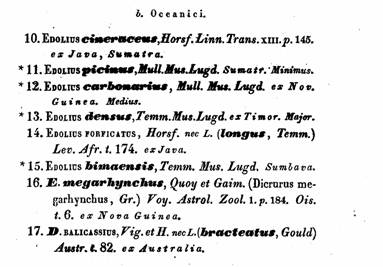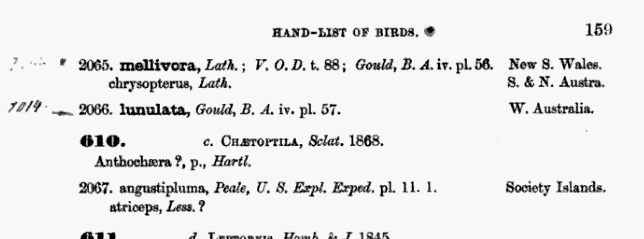Forpus crassirostris
In the past referred to as Forpus xanthopterygius.
Collar, in Handbook of Birds of the World Vol.4 states
"...F. xanthopterygius was shown in 1905 to have been applied to
an immature Brotogeris chiriri, but which was mistakenly reinstated
in 1945, when present species was separated from F. passerinus."
Odontospiza caniceps generic placement
- Usually as Lonchura griseicapilla Delacour 1943.
- Baptista et al (1999) published on the relationships of some mannikins and
waxbills in the Estrildidae (J. Orn. 140: 179-192), based on downy plumes,
nestling palate markings, begging vocalizations, agonistic and courtship
behavior, and allozymes. They proposed
- that the genera Padda and Euodice should be merged with Lonchura;
- Spermestes should be recognized and Odontospiza belongs to
Spermestes;
- Odontospiza caniceps (= Lonchura griseicapilla) becomes Spermestes
caniceps.
Thanks to Norbert Bahr for bringing this to my attention.
More thanks yet to Normand David for pointing out the problem here.
His comments (slightly edited) are:
All mannikins are treated in Lonchura Sykes 1832, which has
priority over all other genera.
Except that nana is maintained in Lemuresthes Wolters, 1949, a replacement
name for Lepidopygia (see Peters XIV: 369-370).
But now Spermestes is lumped into Lonchura, and cucullata is the type
species of Spermestes, now called Lonchura cucullata.
Then I think that it is not possible to use Spermestes as a distinct genus
from Lonchura for only caniceps Reichenow, 1879, when cucullata -the type
species- is not included.
If caniceps alone is not placed in Lonchura, then the correct name would be
Odontospiza caniceps (Reichenow, 1879) because caniceps is the type species
of Odontospiza -see Peters XIV: 368.
[End of N. David's comment]
All this makes sense to me, suggesting Spermestes can not stand as the genus
group name.
Cryptosylvicola Sytematics
Placement with the family is uncertain, and no authority should
be afforded my locating it between Randia and Newtonia.
This speculative placement is based on a suggestion from
Paul Salaman. Further work is being done on the genetic
relationships, and I expect it's placement to change.
Ibis 138(2): 153-159. 1996..
Otus capnodes
See Rasmussen PC, Schulenberg TS, Hawkins F and Voninavoko R. 2000. "Geographic variation in the Malagasy Scops-Owl (Otus rutilus auct.): the existence of an unrecognized species on Madagascar and the taxonomy of other Indian Ocean taxa. BBOC. 120:75-102.
The name is derived from the greek word for "smoky".
The type is felt (by Richmond) to be either in the Norwich museum or in the
Cambridge museum.
Rasmussen et al. consider all the Cambridge museum
examples to be syntypes, and the Norwich museum example to be the selected type.
Certhilauda chauna systematics
Based on morphologic, genetic and geographic data, Ryan and Bloomer
have revised the Long-billed Lark complex. The position of C. chauna is not resolved.
Ryan PR, Bloomer P. The Long-Billed Lark complex: A species
mosaic in southwestern Africa. 1999. Auk 116(1):194-208.



